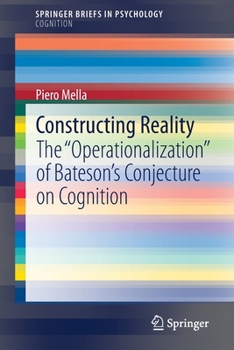Constructing Reality : The Operationalization of Bateson's Conjecture on Cognition
1. Bateson's Model of the Mind and the Fundamental Conjecture on Cognition
1.1 Introduction. Dimensions of Knowledge
1.2 Bateson's Model. The "Mind" as a Calculator and Transformer of Differences in Cognitive Systems
1.3 The Framework of Bateson's Constructivist Logic
1.4 Hypothesis on the Structure of the "Mind" to Operationalize Bateson's Theory
2. Beginning the Operationalization Process. First Step: Descriptions. From Dimensions to Objects
2.1 Bateson's Model in Action. Differences
2.2 Bateson's Model Expanded. The "Mind" as a Calculator of Similarity and Analogy. The Construction of Dimensions
2.3 The First Step Toward Knowledge: the "perception of "objects" in the constructivist perspective
2.4 The "Technical Descriptions" of Objects
2.5 Bateson's Hypothesis in Action
2.6 Comparing Objects. Simple and Composite Objects; Separate and Unified Objects
2.7 Sets, Classifications and Systems (some considerations)
3. Second Step: Definition. From Objects to Concepts
3.1 The Second Step Toward Knowledge: the Process of Definition. From Objects to Concepts
3.2 A Fundamental Step: Determination of the Dimensions
3.3 The Three Paths of Knowledge in a Two-Dimensional Cognitive Universe
3.4 The Human Mind Constructs Meaningful Technical Definitions
3.5 Mental Representations of Objects of Observation
4. Communication. Signs and Languages
4.1 The Communication Process. The Signification Process. Signs, Denomination, Signifier, Seme and Sememe
4.2 From Signs to Languages
4.3 Factual truth and falseness
4.4 The Generalizing Analogical Abstraction. Scientific Laws and Theories (some observations)
4.5 Conclusions and Further Developments





